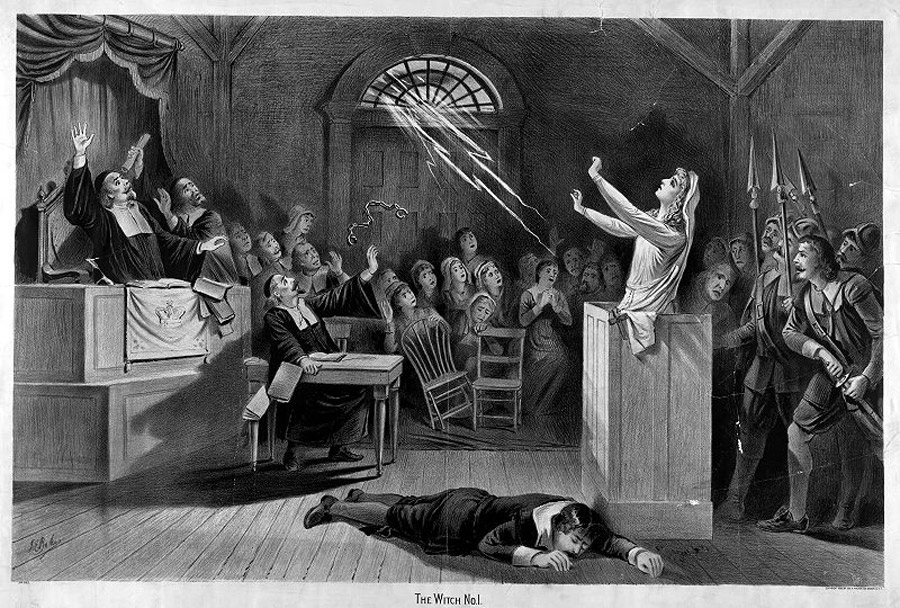The Salem witch trials, which resulted in several deaths in 1692 in the small town of Salem, Massachusetts, have never been adequately explained. One theory which could explain the apparent madness of the trial and judicial hangings may be found in the bread the settlers were eating.
It all began in 1692 and 1693 when Salem in the United States was troubled by sudden accusations of witchcraft. Two young girls named Abigail Williams and Betty Parris, who lived in the small puritan town, showed strange symptoms.
Abigail was known to be a well-behaved girl up to that point. However, she started behaving very strangely, claiming that someone was biting and pinching her. She even yelped and leaped about, and it seemed that she was trying to fly.
After this incident, many other people in the village started showing the same symptoms. But none of the expected causes seemed to fit as none of them had epilepsy or had a fever.
At times, the afflicted people were very reserved and quiet. But in other times, they behaved in mysterious ways that included garbled speech. A number of doctors examined them but failed to identify the cause of such unusual symptoms.
The Salem Witch Trials
When a local doctor named William Griggs diagnosed the young girls, he concluded, perhaps without sufficient medical evidence, that they were bewitched. The town, desperate for a solution to the baffling madness sweeping through its population, seized on the diagnosis.

With the number of accusations of witchcraft increasing, the town decided to search for the witches of Salem and execute them all. By the time the Salem witch trials ended, 19 people had been executed. All of them were accused of being witches.
Not all the accused were hanged, and some received cruel and unusual punishment. One was crushed with stones, and four of the accused were left to die in prison. However, even after hundreds of years of the incident, a question that still arises in people’s minds is whether witches haunted the town of Salem. Or was there an entirely different devil at work?
The Theory of Ergot Poisoning
In 1976, Rensselaer Polytechnic Institute’s Dr. Linnda Caporael first came up with evidence that ergot might be the real culprit and not witchcraft. According to the theory proposed by Caporael, the intense and brief illnesses among the residents of Salem were due to ergotism.
Ergot is a kind of fungus that forms hallucinogenic drugs in bread. The fungus usually thrives in climates where cold winter conditions are followed by wet springs.
The victims of this fungus may suffer from hallucination and paranoia, spasms and cramps, and cardiovascular issues. It may even seriously impact the immune system of people.
Ergot is believed to have grown on the staple crop of the townsfolk: rye. In this way, the residents of Salem may have consumed the fungus. According to Caporael, as ergot was hallucinogenic, it could explain the strange symptoms exhibited by the girls, as well as the general feeling among the townsfolk that they were being attacked by witches.
The fungus was quite common in Europe and America at the time. It was so common that people even thought it was a part of the plant and were not aware of its dangerous properties.
The Evidence Stacks Up
After Dr. Linnda Caporael, scholars such as Mary Matossian also agreed that it was ergot that was the real culprit. In terms of agriculture, the growing conditions of Salem were perfect for ergot to grow and flourish.
During 1691, rainfall and damp conditions would have supported the spread of ergot on the rye. Moreover, the people of Salem were unaware of what ergot was, and the link was never made at the time to the contaminated food.
The social conditions of the area also supported the theory that ergot was behind the strange behavior of the young girls in the village. According to the notes of Caporael, the minister bought grain from the western parts of the town.
His daughter and niece were among the first affected by the strange symptoms. Moreover, most afflicted individuals lived in the western part, and it is suspected that these supplies were the ones contaminated.
Besides all these facts, the symptoms shown by the bewitching people matched the known symptoms of convulsive ergotism in modern medicine. With a few exceptions, most of the strange behavior exhibited by the people was similar to the symptoms of rye-induced ergotism.
When ergot infects the rye plant, it grows and eventually replaces the shoots with its own hardened fungal sclerotia. Ergot sclerotia form purple-black growths that contain ergotamine and lysergic acid, both dangerous if ingested.

The people living in the village of Salem were unaware of the danger and thought that the darker shoots of the rye plant were due to overexposure to sunlight. So, they considered the crop fit for eating even though it was poisoned by ergot.
Ergot Poisoning
Ergot ingestion usually leads to severe convulsions, delusions, muscle spasms, and more. Severe hallucinations are also a symptom owing to the presence of lysergic acid. The young girls in Salem showed all these symptoms.
Further, ergotism would have appeared first in adolescents as their immune system was not completely developed, putting them at high risk of the disease. This fits with the timeline, with the first examples of strange behavior coming from girls in the town, preceding a more general malaise.
However, the town doctor was not aware of the existence of the disease named ergotism, and instead made a diagnosis based on his religious beliefs. So, he concluded that the symptoms shown by the young girls were because they had been targeted by witchcraft. It is possible that the girls themselves, unable to explain their symptoms, believed the same.

The villagers also readily accepted the witchcraft theory, and the trials were started to oust the “witches” they believed walked among them.
The Salem witch trials finally came to an end in May 1693. This sudden resumption of normal behavior was not because the witches were driven out. Instead, it was because the ergot-contaminated grain had been exhausted by this point.
Conclusion
The Salem witch trial stills remain a topic of much debate among people. A number of social psychologists suggest that the behavior of young girls could be due to the political and social unrest in the area.
Famously, Arthur Miller’s play The Crucible blames an intolerant and repressive society, and a wilful need for attention in the young girls, as the cause. However for a change so sudden and so widespread to affect only a single community requires a more tangible explanation.
Unfortunately, it will probably remain unknown what happened in the Salem witch trials. However, one thing all the scholars agree on is that there wasn’t any supernatural power at work.
Top Image: The Salem Witch Trials. Source: Thomas Satterwhite Noble / CC BY 3.0.
By Bipin Dimri